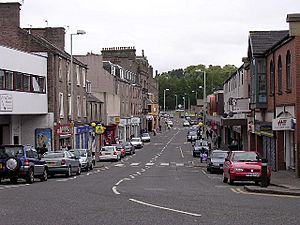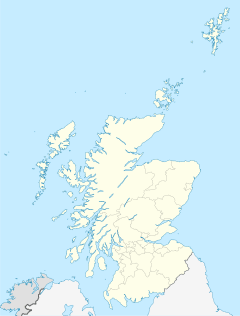Lochee facts for kids
Quick facts for kids Lochee |
|
|---|---|
 |
|
| Population | 5,218 |
| OS grid reference | NO378317 |
| Council area | |
| Lieutenancy area | |
| Country | Scotland |
| Sovereign state | United Kingdom |
| Post town | DUNDEE |
| Postcode district | DD2 |
| Dialling code | 01382 |
| Ambulance | Scottish |
| EU Parliament | Scotland |
| UK Parliament |
|
| Scottish Parliament |
|
Lochee (/lɒˈxiː/) is an area in the west of Dundee, Scotland. For a long time, it was a separate town. However, during the 1800s, Dundee grew larger and eventually surrounded Lochee. This area is well-known because it was home to Camperdown Works. This was the biggest factory in the world for making jute products.
Contents
History of Lochee
The name 'Lochee' originally came from a small stream. This stream flowed through an area called Balgay Lochee. People who lived there were weavers, and their cottages were near the stream. The name means "eye of the loch" or "Loch E'e." This eventually became Lochee. It's thought that this old site is near where Myrekirk stands today. Old maps from the late 1700s, like John Ainslie's map of 1794, show 'Locheye' near the stream.
In the 1400s, a family called the Duncans drained the loch. They offered land for farming along the stream. One of these farming spots went to a Dutch family, the Coxes. The Cox family became known for making good quality linen. By 1700, they had set up their own business selling linen.
By 1760, the Cox family business had 300 weavers. They started using steam power and moved into the jute industry. Jute is a strong natural fiber used to make things like ropes and sacks. In 1864, the family built Camperdown Works. This factory was said to be the largest in the world. It had more than 5,000 employees!
A famous part of the factory that still stands today is Cox’s Stack. This is a very tall chimney, 86 meters (282 feet) high. It was designed by a local architect named James MacLaren. Lochee became like a "company town" because of the factory. It had its own police force, fire service, schools, and even two railway stations. It also had a swimming pool, a library, and several churches.
In 1890, the Cox Brothers gave a large public park to Lochee. This park was 25 acres in size, which is about the size of 19 football fields.
Immigration to Lochee
Many people moved to Lochee because they could find work in the city's jute factories. By 1855, about 14,000 Irish immigrants lived in Dundee. Most of them settled in Lochee. Because of this, Lochee became known as 'Little Tipperary.'
In 1904, the Lochee Harp football club was started by Irishmen living in Lochee. It gave the new immigrants a way to relax and play sports. The club is still playing football today. Lochee is still seen as Dundee's Irish "quarter" or neighborhood.
Notable People from Lochee
Many interesting people have come from Lochee. Here are a few:
- George Barnes, a politician.
- Henry Bradley, who was a cattle driver in Canada, a boxer, and imported wine.
- W. Lindsay Cable, an illustrator for famous books like those by Enid Blyton.
- William Cooper, a ship captain and politician in Prince Edward Island, Canada.
- James Crabb, a classical musician.
- John Duncan, a footballer.
- William Eassie, who built railways and made wooden buildings.
- Robert Fleming, a banker.
- George Galloway, a politician.
- Frank Gilfeather, a journalist, broadcaster, and author.
- Sir Alexander Gray, a poet.
- James 'Napper' Thomson, a businessman.
- Michael Marra, a musician.
Lochee Today: Demographics
Here are some facts about the people living in Lochee, based on information from 2011:
- Total Population (2011): 5,218 people live in Lochee.
- % children (2011): About 17.63% of the people in Lochee are children.
- % working age (2011): About 58.49% of the people are of working age.
- % pensionable age (2011): About 23.88% of the people are of pensionable age.



